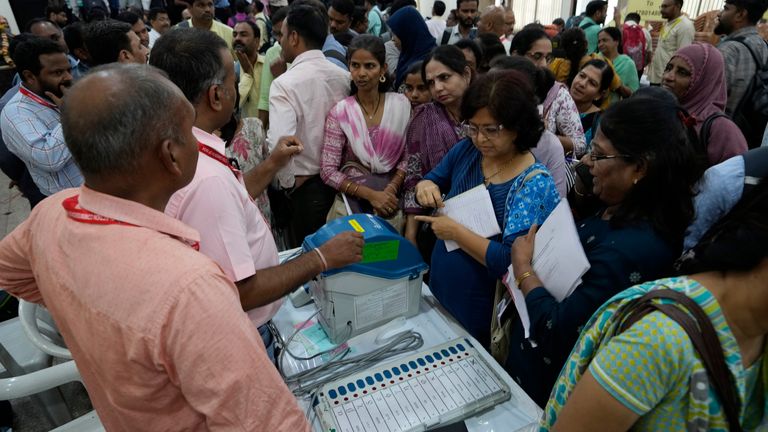
Mukesh, a 22-year-old from Munak in the northern state of Haryana, shows Sky News the scars all over his body he says are from torture in a Russian prison.
He alleges prison guards stubbed their cigarettes out on him and regularly beat him up for months while he was incarcerated.
Mukesh is one of the many young men from Haryana who have taken dangerous journeys in search of work abroad.
Sky News has reported on several men who have ended up trapped and forced to fight for the Russian army in the Ukraine war.
“There is a lot of unemployment here and I wasn’t getting a job,” Mukesh says.
“An agent promised me work in Germany but I was sent to Russia instead.
“I was arrested for visa violations. When I refused to join their army and fight for them in the Ukraine war they jailed me and tortured me very badly.”
High unemployment, shrinking incomes, and the cost of living crisis in rural parts of India have driven many young men to make these dangerous journeys.
As the country wraps up its mammoth seven-phase election that will have lasted 44 days, the results for which are due on 4 June, Prime Minister Narendra Modi is expected to win a third term.
The final round of voting takes place in the last seven states and union territories on 1 June.
High inequality despite growth claims – with rival emerging
Modi is never shy of boasting about his economic achievements and stresses that under his government the country overtook the UK as the world’s fifth-largest economy.
But what goes unmentioned is that GDP per capita remains dismal and on a per-person basis India ranks 136th globally.
Inequality is at an historic high – even more stark than it was under British rule.
According to a report by the Paris-based World Inequalities Lab, the top 1% of India’s population controls 40% of the nation’s wealth. That’s higher than in the US, South Africa, and Brazil.
The cost of living and inflation have had a detrimental effect on household savings, which are now at a five-decade low while household debt is at a record high.
The consumer market is sluggish and private consumption is at its lowest in 20 years.
Read more:
The digital election in India
Modi’s BJP party notably absent in Kashmir
Modi reported for calling Muslims ‘infiltrators’
Nalin Kohli, national spokesperson for the ruling Bharatiya Janata Party (BJP), tells Sky News: “If you look at the last 10 years, in several areas the speed and the scale at which work and progress has taken place is not seen ever before.
“We in any case are possibly the fastest growing economy in the world and today a very attractive investment destination.”
But opposition parties have consistently flagged the issues of unemployment, inflation, the cost of living, and farmer woes – and have recently picked up popularity with young people as a result.
Main opposition leader Rahul Gandhi is tenacious in his attack on Modi’s economic policy.
Setting out his own at a political rally in Delhi, he said: “We will waive farmer debts, give them a minimum support price for products, increase wages for workers, and will double the pay of women health workers.
“For the youth, our first decision will be to give three million government jobs.”
The crowd responded with loud cheers.
Modi credited with cleaning up finance, but there are problems elsewhere
Modi is credited with cleaning up the financial system, bringing in banking sector reforms, goods and services taxation, digitisation, and improving the business landscape.
Crucial bureaucratic systems that have been perennially sluggish have been made to shape up or ship out.
His government’s focus on building and developing India’s creaking infrastructure has provided a much-needed boost to the economy.
In the last three years, more than $100bn (£79bn) has been spent annually on infrastructure.
The Sensex, India’s stock exchange, is soaring, but at the same time, there are structural problems in many sectors.
Manufacturing has stagnated – particularly medium and small-scale businesses – the backbone of the economy.
Foreign direct investments have plunged to almost a two-decade low.
Domestic business is shying from investing in the economy and most investment is government-driven.
60% need food rations – but ruling party still popular
An overwhelming majority of the population is directly or indirectly associated with agriculture.
Rural distress and falling farm incomes have led to widespread protests by farmers across the country.
In 2020, farmers lay siege to the borders of the capital for 13 months protesting against three agriculture laws.
Modi eventually relented and the farm laws were withdrawn.
Avik Saha, a farming leader, says: “India has the highest number of farmer suicides. This has to be the greatest indicator of distress.”
India also ranked 111th of the 125 nations in last year’s Global Hunger Index report.
Modi’s government, however, has rejected the report.
A 2023 joint report by the Food and Agriculture Organisation, UNICEF, World Health Organisation, and World Food Programme, found that 74% of the population cannot afford healthy food.
Last year Modi announced the extension of a free food ration scheme to 800 million Indians for the next five years.
Critics question if India is doing so well, then why does 60% of its population need free rations?
His government is spending more than $400bn (£315bn) on roughly 300 welfare programs and e-subsidies targeting millions of beneficiaries.
It includes homes, toilets, cooking gas cylinders, and even cash transfers to farmers.
Mr Kohli says: “Why do you not see voters rejecting the BJP in a large number if they were unhappy?
“Why are we winning? And if we go by the general sentiment, I believe this mandate is poised to increase – that’s the general sense.”







